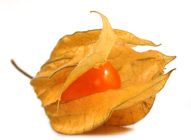Languages
Physalis

The physalis (or cape gooseberry) has nothing in common with the European gooseberry, but is a member of the nightshade (solanaceae) family. After ripening, the fruit becomes light brown, its husk is deeply ribbed and dry. In it, the slightly sticky, golden yellow and nearly round berry fruit can be found, with a diameter between 1.5 and 3(4)cm and a weight of 4-5(15) grams. The pulp of the physalis is yellow, juicy and has many small, soft and edible seeds. The taste is fruity and refreshing, elegantly sweet and reminds remotely of a pineapple (also named: pineapple cherry). It is rich in citric acid, phosphor, iron, provitamin vitamin B, and 11-42m% vitamin C.
The physalis, has its origin in the Andes region between Venezuela and Chile. Today, the plant is cultivated in many regions with a moderate climate. Besides Venezuela and Chile, main growers are: Columbia (principal exporter for European markets), South Africa, Kenya, India New Zealand and the US (California and Hawaii).
